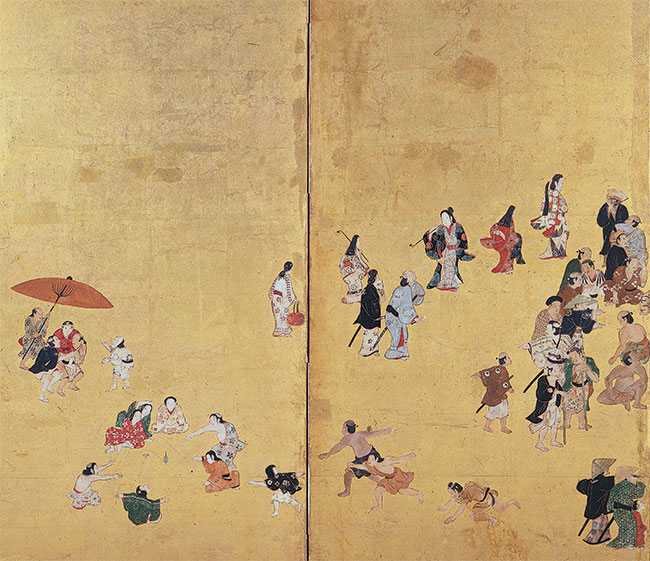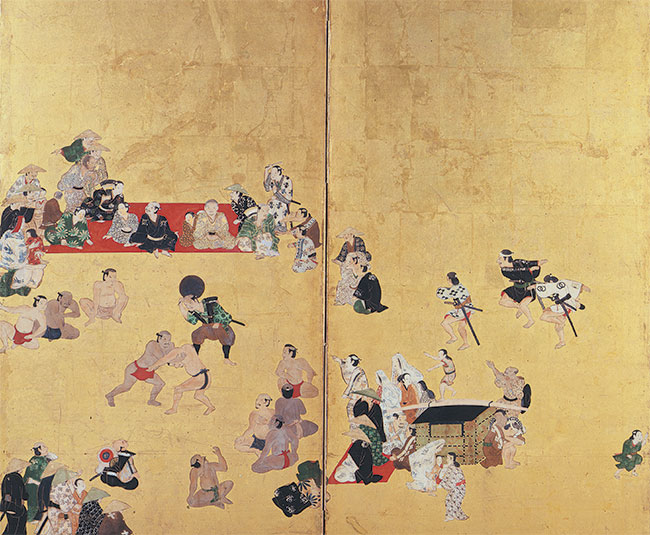
anonymous
late 17th/early 18th century
Asobi
(Amusements)
six-panel screen; ink, color, gofun, and gold leaf on paper
painting 30 3/4 by 107 1/4 in., 78 by 272.4 cm.
overall 35 3/4 by 112 1/2 in., 90.8 by 285.8 cm.

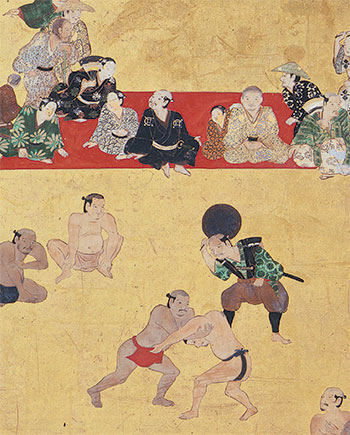
The half-size six-panel screen depicts a variety of asobi (forms of play) on a gold leaf ground with a sumo match and its spectators at the center of the composition. The two stocky wrestlers are locked in each other's grip, one grasping his adversary's shoulders, the other pulling at his opponent's mawashi (wrestler's loincloth). A manager stands nearby holding a large circular fan decorated with a silver kikumon (stylized chrysanthemum crest) on an iron-orange ground (both metallic pigments have oxidized to a very dark color). At opposite sides, several additional wrestlers are seated, presumably representing the competing dojo (sumo house). A seated man with a fan decorated with a janome-mon (circular snake's eye crest) attached to his back is likely the manager from the opposing house. A number of spectators encircle the fight, apparently shouting and exclaiming in response to the wrestlers' deadlock. Their animated reactions add to the excitement and tension of the match. The sponsor of the match may be a man clad in a deep blue robe decorated with white shippo-mon (crest of intersecting circles) facing the wrestlers while seated on a large red cloth. His importance is underlined by his relative isolation on the mat. On either side of him are two boys, perhaps his sons, and an elder man with his head completely shaven (probably a monk), sits nearby. At the opposite end of the mat, an adolescent boy is clad in a malachite-green kosode (robe) decorated with the same kikumon found on the standing manager's fan. Several men, presumably attendants and retainers, wait at a respectful distance while enjoying the match.
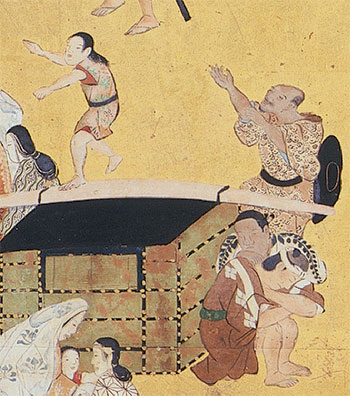
Surrounding this central scene are other examples of asobi. To the right, a trio of male dancers prepares to join the entertainments. Below, a young boy balances himself on the narrow beam of a palanquin as an older man rushes to catch him. Moving further to the right we find a group of men chasing each other-perhaps in play, or perhaps not. Above, a finely attired lady of high rank (indicated by her attendant holding a very large umbrella) pauses to adjust her hood while her child runs ahead, in the direction of a group of boys playing mekakushi (similar to blind-man's buff). Below, another group of boys are playing kotori, a tag game in which one child tries to capture another from the group (see Christine Guth, Asobi, p. 26). At the lower right corner, a beauty and a young girl accompany the very unusual depiction of a pregnant woman.
At the lower left corner of the screen, a group of adolescent boys run across the foreground toward a circle of boys and girls playing with a koma (spinning top). Above, a procession of elegant beauties approaches the match. The group is led by a striking figure, perhaps a high-ranking courtesan, her kosode decorated with red, orange and blue on a white ground, followed by a young girl, presumably her kamuro (apprentice courtesan). A second courtesan and her kamuro follow, both carrying elongated tobacco pipes. The arrival of the beauties has apparently caused a stir as several men have paused to peer over their fans and discreetly watch their entrance. A young girl at the end of the procession carries a red paper lantern, the only clue on the screen providing any suggestion of the time of day. As she is not leading the way at the moment, perhaps the lantern will be needed to light the way home later in the evening.
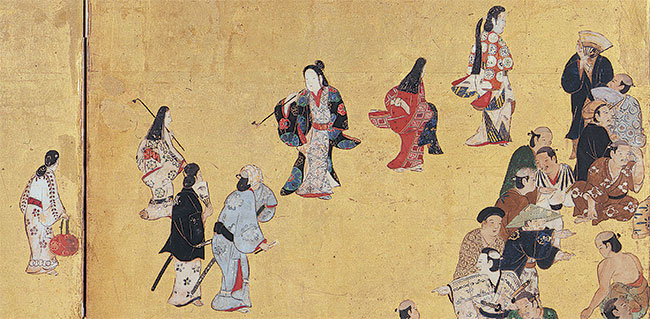
In the Edo period, scenes depicting everyday life and the pleasure quarters became increasingly popular in genre painting. The focus of the artist shifted away from panoramic views of outdoor scenes and depictions of compartmentalized classical literary subjects. Instead, the emphasis was on people themselves, and their escape to the unreal worlds of pleasure and play. Stylized gold clouds typically used to define time and space, gave way to solid gold grounds. Here, in this screen, we have a variety of amusements suspended in time and place. There are no indicators such as landscape or architecture to define the context, only the figures themselves in the act of play.

The women's hairstyles, limited to either the hyogo mage (with small topknot), long ponytail, or worn loose, combined with the layered kosode or furisode (swinging sleeves) and uchikake (outer robe left open) with relatively narrow obi (waist sash) are all characteristic of dress in the second half of the 17th century (for hairstyles, see Kyoto National Museum, Miyako no Keishu Rakuchu Rakugai no Sekai, pp.130-133). With the exception of the men seated on the mat and a few of the women, the majority of the figures depicted are clad in kosode decorated with simple patterns and geometric motifs based on mon (family crests). A few mon, or variations of, are repeated on several figures: such as the kikumon previously mentioned, the hishi (diamond), hanabashi (flower diamond), suhama (circular) fujimon (wisteria) and the kuruma (wheel). It may not be a coincidence that the mon of the sumo managers' fans are based on the same motifs (chrysanthemum and circular) as the mon of two of the figures seated on the red mat. Perhaps this is a view of an evening of entertainments hosted by the patrons of the dojo, and the attendees are their respective households, that is, families, friends, and servants. The intermingling of the asobi of children and the asobi of adults (without venturing into the pleasure quarters) contributes to the lighthearted atmosphere of the painting.
price: Contact gallery
